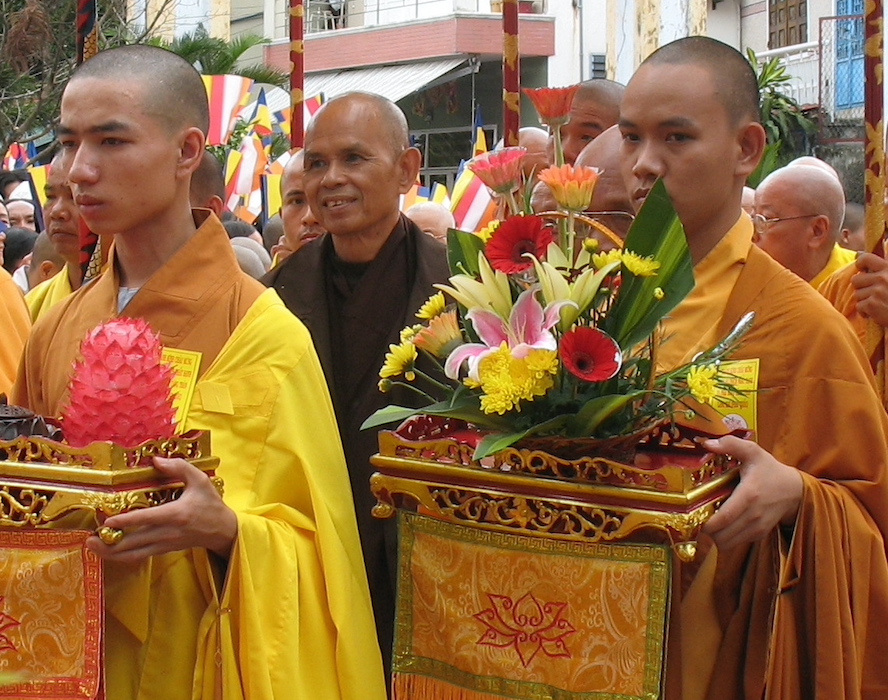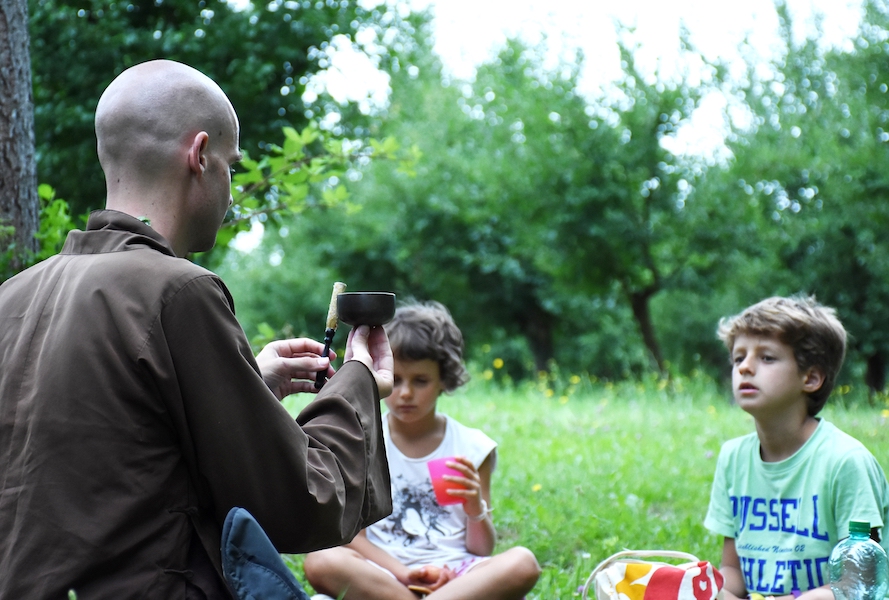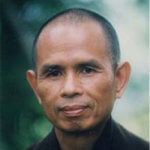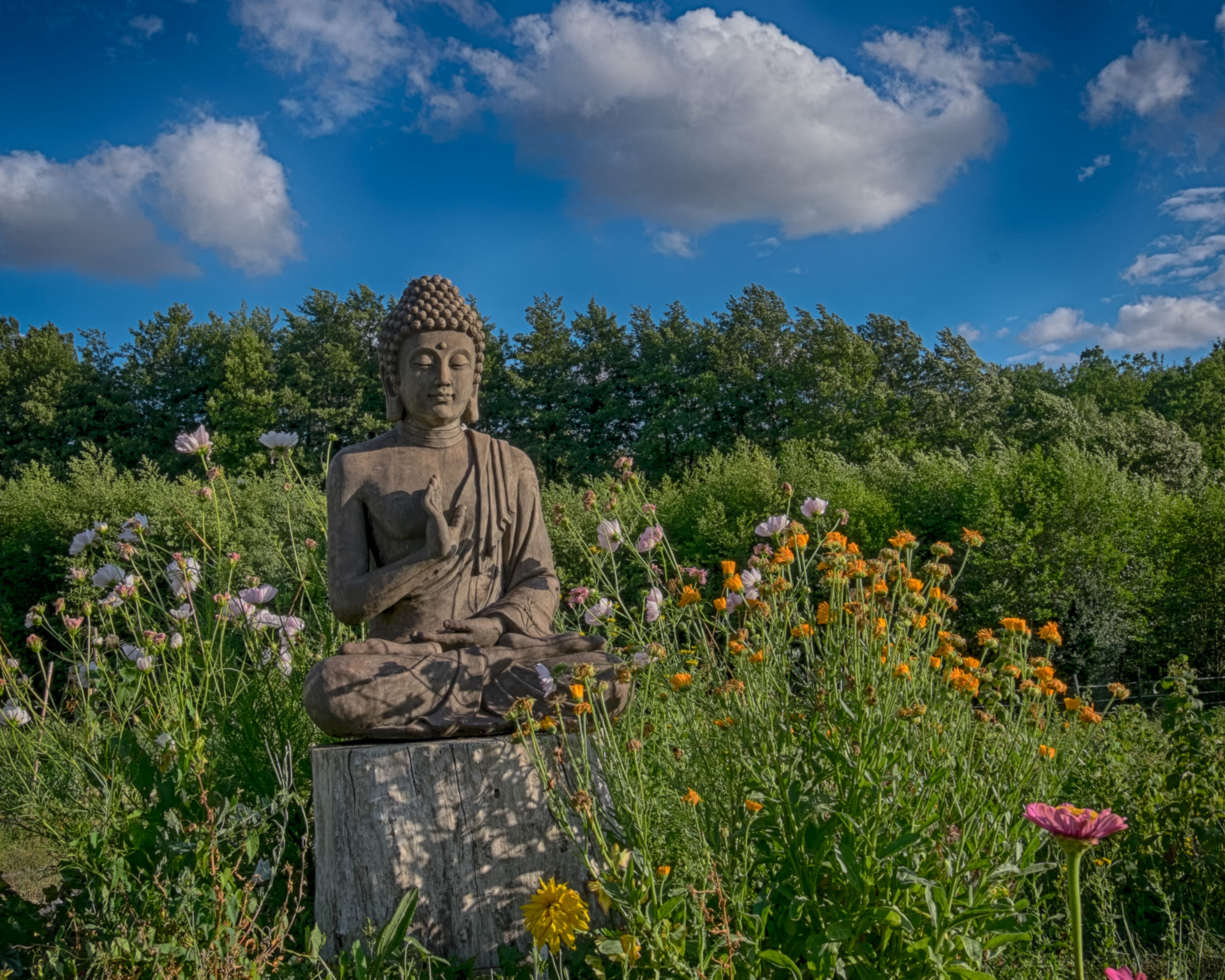By Thich Nhat Hanh in June 2020

Retreat on Buddhist Psychology
Key West, Florida
November 8, 1997
Dear friends,
At a past winter retreat in Plum Village, everyone was given an assignment to write a love letter to their father.
By Thich Nhat Hanh in June 2020

Retreat on Buddhist Psychology
Key West, Florida
November 8, 1997
Dear friends,
At a past winter retreat in Plum Village, everyone was given an assignment to write a love letter to their father. A young American named David thought that he could not do it. He told us that every time he thought of his father the suffering overwhelmed him, so he couldn’t bear to write him a letter. His father had passed away, and yet he could not reconcile with him. When I learned of his situation, I offered him the exercise of the five-year-old boy.
Breathing in, I see myself as a five-year-old boy. Breathing out, I smile to the five-year-old boy that was me.
I asked him to practice that for a week during walking meditation, sitting meditation, doing things in the garden, in the kitchen, and so on.
When you breathe in and see yourself as a five-year-old child, you can touch your vulnerability and fragility. At this age, we are so fragile that a stern look from an adult can create a wound. When your father shouts at you, “Shut up!” you receive another deep wound in your heart.
As a five-year-old child, you have suffering and difficulties. Sometimes you try to express them to your father or mother, but they are not patient enough to listen, and you don’t have enough words. You try your best, but they get irritated, and then they shout at you. It’s like a bucket of ice water poured on your heart. The next time you won’t dare to try to share your feelings. You are fragile and vulnerable as a five-year-old child, and when you see that, compassion will arise in you.
Breathing in, I see myself as a five-year-old boy. Breathing out, I smile to the five-year-old boy who was me.
When you identify the little child in you, soon you realize that your child is always alive and needs your care. You have deserted your child for a long time. Your child may be deeply wounded; and you need to help, embrace, and heal your child so the wounds won’t remain forever. This practice should be done during the first week.
Every mindful in-breath, every mindful out-breath, every peaceful step, every smile is an act of liberation.
The next week I gave him another exercise:
Breathing in, I see my father as a five-year-old boy. Breathing out, I smile to that five-year-old boy who was my father.
It is helpful to visualize your father as a five-year-old boy, as fragile and vulnerable as you were when you were five. You might want to get a picture of your father as a five-year-old boy to help you practice.
Breathing in, I see my father as a five-year-old boy. Breathing out, I smile to that five-year-old boy.
Maybe this is the first time you are able to see your father as a vulnerable little child, and you begin to understand your father might have been a victim like you when he was five. He might have been abused by his father and didn’t have a chance to meet a teacher or to have a Sangha help take care of his wounds. That is why he allowed that seed of suffering to rise up in him, and he has transmitted that internal formation to you. To get back at him now is unjust. He needs to be helped and not to be punished. So:
Breathing in, I see my father as a five-year-old boy. Breathing out, I smile to him.
This is a smile of understanding and of compassion.
The young man from America also got a picture of his father as an adult, and he placed that picture on his table in his room in the Upper Hamlet. Every time he was about to leave the room, he would stop by his table, turn on the light, look into the eyes of his father, and practice mindful breathing.
Breathing in, this is my father. Breathing out, I smile to my father.
And every time he entered his room, he would practice this before he lay down on his bed.

The Emptiness of Transmission
I also offered him the meditation on the Emptiness of Transmission. What does it mean? It has to do with the teaching of the Fifty Verses [on the Nature of Consciousness]. Emptiness of transmission means that everything depends on everything else, that nothing is separate. In every transmission there must be three elements: First, there must be a transmitter; then there must be an object to be transmitted; and then there must be a receiver of the transmission.
Every time you take a shower, breathe in and out deeply, and look at your body as an object of transmission. Who has transmitted this body to you? Your father and your mother. What have they transmitted to you? They have transmitted themselves to you, nothing less. Are the transmitter and the transmitted two or one? They belong to a pair of opposites. You can say two, you can say one. Reality is like that; it is free from concepts. That is the meaning of nirvana, “the extinction of all concepts.”
The third element is called “the receiver of the transmission.” Who is he? Is he distinct from the object transmitted and the transmitter? That body that has been transmitted: Is it one with you or two? If you look deeply into the nature of your body and the nature of transmission, you will see that there is an emptiness of transmission. Although we think there are three elements, the three elements cannot be separated. Neither the same nor different. That is the training. You have to learn how to look at things like that in order to begin to perceive the realm of things in themselves.
When David was young, he was very bold. He declared: “I do not want to have anything to do with my father.” But is it possible for us not to have anything to do with our father? Can you take your father out of yourself? When you look deeply, you see that you are the continuation of your father. You are your father. There is no escape.
So if you declare that you don’t want to have anything to do with your father, that is only your anger, your wish. In reality that is impossible because you are your father. It is better to reconcile with your father within you. It is better to reconcile with yourself. One day, after crying a lot, David sat down and began to write a love letter to his father. Because of the insight that came from that practice, he was able to see his father’s suffering and his own ignorance.
I told him, “If you don’t practice, you will transmit that suffering to your children and your grandchildren.” You practice for your parents and for your children and their children. When you are able to make a peaceful step, it is not for you alone. You do it for all your ancestors, and you do it for all your children and future generations. When you are able to smile, all the ancestors in you are able to smile. It is very important. You need a Sangha to support you for that smile to become possible.
You may think that a smile is nothing, but it is a lot. With a true smile, you make all generations of ancestors in you smile. It is liberation; it is transformation. Every mindful in-breath, every mindful out-breath, every peaceful step, every smile is an act of liberation. You offer liberation to your ancestors and to your children.
Acknowledging the Good
During that Winter Retreat, another assignment was to write down the wholesome qualities of your father and your mother. That is an easy exercise, helping you to see all the good values of your parents.
Michel also came from North America, and for him it was not difficult to write down the good qualities of his father because his father is wonderful. But for his mother, it was difficult. It did not seem that his mother had a lot of good qualities, so he was a little bit skeptical that he could do it. But because he had been asked to do it, he practiced mindful walking, mindful eating, mindful sitting, mindful working like any other practitioner. And one day he sat down and began to look deeply to see the good qualities of his mother. After a few hours of work, he was surprised. He thought he wouldn’t be able to write more than three lines, but he wrote almost two full pages.
You practice for your parents and for your children and their children.
He found that he was carrying some resentment toward his mother. One time he got into great difficulty with his mother, and that overwhelming suffering prevented him from seeing many of her good qualities. During those few days of practice, he discovered a new mother, and it made him cry for joy. Because of some anger and some resentment, you are not capable of seeing all the good qualities of the person you love; and in this way you might have been unjust to them. This exercise will help you repair the injustice you have done to the person you love.
After having done the homework, Michel wrote a letter to his mother as instructed. In the letter he said that thanks to this meditation, he has discovered a new mother, and he is very proud of her. He is very happy to feel like that—you feel like the happiest person on Earth—because he now realizes that he has a mother with so many good qualities.
The letter helped his mother to discover a new son, because he had never talked to her like that before. A simple letter can reveal two treasures: a new son and a new mother. She cried a lot. She cried happily. But she also felt some bitterness because she wanted to write a letter like that to her own mother, but her mother was dead.
So she telephoned her daughter-in-law and told her about it. “My daughter, your husband just wrote me a lovely letter, and I am almost the happiest mother on Earth because I received such a letter, but I desire so much to write a letter like that to my mother. Unfortunately, my mother is dead.”
The daughter-in-law telephoned Michel in Plum Village and told him about his mother’s wish, and Michel wrote another letter to his mother. He said, “Mother, my teacher told me that my grandma has never died. She is still alive in you. If you practice breathing in and out deeply, you’ll find her still alive in you. So write the letter anyway. I’m sure that my grandma will read it.” The insight had been transmitted to the son, and the son transmitted the insight to the mother. That goes perfectly with the teaching that you find in the Fifty Verses.
Sitting in her own country, the mother also practiced, writing a letter to her mother because she understood through her son that her mother is still alive in her. This is not a dream; this is the truth. If we are able to touch the ground of our being, we will touch the realm of no-birth and no-death. Nothing is lost, nothing needs to be recovered. Everything is still intact if you know how to establish yourself deeply in the present moment and look deeply into what is there. The practice is wonderful and has the power of liberating, of restoring non-fear, peace, and joy.
Dealing with Violence
When we feel that we have been abused, when people have treated us with violence and racial discrimination, a block of suffering is in us. If we do not know how to handle and transform the violence in us, that violence is going to destroy us and destroy the people we love. When parents treat children with violence, they can’t use violence back because they are only children. So that violence penetrates deeply into their inner self and begins to destroy. Even if they return the violence, it doesn’t disappear. In prisons, a lot of criminals—especially the young ones—are there because they have not been helped to take care of the violence within and to transform it.
Terrorists have suffered a lot because of violence, and the violence in them is very strong. Because they don’t know how to transform that violence, they send violence back to society. They use bombs, they use guns, they use fire to burn. In France, they burned a lot of forest just because they wanted to destroy and retaliate. They don’t know whom to punish, so they do whatever they can to just destroy.
Sometimes they destroy thousands and thousands of acres of forest. It is very easy to do that during summertime. They are not aware that by burning the forest they are burning themselves. They don’t know that, when placing a bomb to kill the people in a bus or in the market, they are killing themselves. But because there is violence in you, if you don’t know how to handle it, it will have to manifest in some way.
In the Confucian tradition, when a daughter-in-law suffers, she doesn’t have the right to say anything unkind to her parents-in-law or to her husband. All she can do is throw herself on the street and roll over and over, or beat herself. She destroys herself because she cannot destroy the people she hates. If violence cannot be used on the people you hate, you turn it inward to destroy yourself. When a young person kills himself, that is not only to seek the end of suffering. That is also to punish the parents and the society. That is why we have to learn how to handle the violence in us, how to help the people around us handle the violence in them, and how to transform it.
In prison, not only do the prisoners suffer, but the prison guards also suffer. When prisoners are violent, the prison guards are also violent, and using violence, both suffer.
In school we aren’t taught how to take care of our anger, how to deal with our violence, and how to transform it. When students are violent, maybe it’s because they have been suppressed by their parents and also by society, so in school they try to get relief and they take it out on their teachers. The teachers suffer, and if they don’t know how to handle their anger, they will become violent toward their students. Both students and teachers suffer.
The police try to preserve peace on the streets. The criminals are violent, and the police have a lot of violence in them too, because they have also suffered a lot. The police are full of fear. Every morning when they are ready to go out for their rounds, they don’t know what will happen to them; they may be killed or wounded by gangsters or other people who hate the police. So the police are motivated by their own fear and desire to remain alive, and they also are trying to suppress the other side with violence. We should be willing to help both the gangsters and the police.
To practice the mindfulness trainings, we need the support of a Sangha, so our practice will be solid.
Mindfulness Practice Centers
Mindfulness practice can help us first to transform the violence within us and to nourish the compassion in us, and the willingness to help change society. Then we have to go out and apply the techniques of the practice in every kind of environment. That is why mindfulness practice must be offered to society. In Plum Village we have meditated for more than a year now on how to offer mindfulness as a nonsectarian and nonreligious practice that can be applied in schools, in hospitals, in prisons, and in society, because according to our experience it is perfectly possible to practice mindfulness in a nonreligious and a nonsectarian way.
Instead of saying, “I take refuge in the Buddha,” you can translate, “I have confidence in my own capacity of waking up and understanding and loving.” That kind of language will be accepted by every religious tradition. That is why I have asked a number of friends in Europe and in America to set up an organization called The Association of Mindfulness Practice Centers, and we hope that in the future there will be at least one center in each city. Today I would like to invite you to join us in looking deeply to find ways to realize this kind of program.
A mindfulness practice center is a place where everyone can come at any time. For example, you may come when we are having a silent meal. After a short introduction on how to enjoy a silent meal, you will be invited to join. If you arrive when we are working in the vegetable garden, you may join our mindful gardening after a five-minute lesson on how to enjoy silent gardening, breathing in, breathing out. We have to train people to lead the practice in these centers. A mindfulness practice center in a city might organize Days of Mindfulness and short and long retreats in the cities or in the countryside.
Three mindfulness practice centers are taking shape now in North America: one is in the Washington, D.C. area, one is in Vermont, and one is in California. In each center there should be a path for walking meditation, a space for sitting meditation, a place for sharing a silent meal, a playground for children, and so on: all the basic activities of a retreat. I think every one of us can support this project. If you are an architect, if you are a poet, if you are a writer, if you are a legislator, or if you are a journalist, you can help with this project.
In the practice of Plum Village, children are always included. I have offered retreats for children in Europe and in North America quite a few times, and children have shown that they are very capable of enjoying the practice. I remember having such a retreat in Southern California. On the last day the children stood in line to practice hugging meditation with me, and they didn’t want to leave! With parents there supporting their children, we had a lovely retreat.
According to our experience, it is absolutely possible to practice mindfulness as a nonreligious practice. You don’t have to bow or to burn incense to do everything mindfully. We invest one hundred percent of ourselves in the present moment. Suppose the person who comes is not used to making a bow? Instead, we can be ready to shake hands and put one hand on the other to show that we are investing one hundred percent of ourselves in shaking their hand: “I am very pleased to meet you.” It’s not just a formula, but it’s being fully present. So please reflect on this.
Mindfulness Trainings
The sex industry and show business are responsible for a lot of suffering in our modern society. We have to practice awareness about the effects that these kinds of industries have produced daily in our lives, both individually and in our society. We should offer the practice to the people we love and to the younger generation, so they will know how to protect themselves. There are those who are only motivated by money and will do anything to get it, selling products full of poisons. We cannot allow people to be intoxicated and destroyed like that. With smoking, for example, we had to legislate protection for our children from the harmful effects of smoking.
If you are a writer, if you are a journalist, if you are a filmmaker, if you are a legislator, or if you are a teacher, please do your best to speak out about this and offer ways to stop people from these destructive activities. The Five Mindfulness Trainings offer guidelines to stop the destruction of our society. We know the Five Mindfulness Trainings are concrete ways of practicing to help society.
If we look deeply into the Five Mindfulness Trainings, we can see the Buddha, we can see the Dharma, we can see the Sangha, we can see the Kingdom of God, we can see the Holy Spirit, we can see Jesus Christ, we can see God. If we are determined to live according to the Five Mindfulness Trainings, we are protected. We can protect ourselves, our families, and our society. That is a solid base for our action. If you receive the Five Mindfulness Trainings and live according to them, you are already on the path of a bodhisattva. You are motivated by a strong desire to protect your society and transform the violence, hatred, and anger in society. Every time I see a person making the determination to receive and practice the Five Mindfulness Trainings, I am very happy. To practice the mindfulness trainings, we need the support of a Sangha so our practice will be solid. A Sangha is essential to our practice: we need each other to practice well. I know that all of us are motivated by the desire to practice. Why practice alone? While it is possible, it is much more difficult than to practice with the support of a Sangha. The Sangha is our refuge; we need our Sangha.
TRANSCRIBED BY ELAINE FISHER. VERIFIED BY GREG SEVER. EDITED BY BARBARA CASEY.


